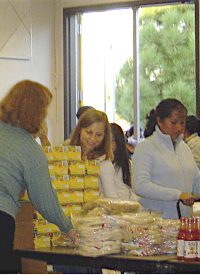
Article audio sponsored by The John Birch Society
But here's the problem with these shocking statements: there is absolutely no truth to them.
The data that allegedly backs up Vilsak's shocking allegations (and Bridges' echo of Vilsak) comes from U.S. Department of Agriculture (USDA) studies on childhood “food security,” a term that is not synonymous with either child nutrition or child hunger. The annual USDA studies do confirm that one in five families in America have “low food security,” but these same studies also demonstrate that only one percent of children experienced actual hunger at any time during 2010 (the most recent year statistics are available).
The September 2011 USDA study Household Food Security in the United States in 2010 explained that “children are usually shielded from the disrupted eating patterns and reduced food intake that characterize very low food security,” and noted that “both children and adults experienced instances of very low food security in 1.0 percent of households with children (386,000 households) in 2010, essentially unchanged from 1.2 percent in 2009.” This can be contrasted with the claims by “Hunger Hits Home” that “more than 16 million children in America struggle with hunger.”
Obviously, even one child in hunger is one too many. But the public is not served by exaggerating the level of childhood hunger from the actual one percent level by twenty-fold or more.
“Hunger Hits Home” profiled three economically distressed families in New York City, Virginia and Texas as examples of childhood hunger, though only children in one of the profiled families has experienced actual hunger, the Walkers of Virginia. “I've gone about three days without eating. I've been able to do that sometimes.” 13-year-old Javier Walker told cameras of his past hunger. “Money is short in our house. We have eaten Ramen noodles three times a day, 24-7 for two-and-a-half to three months.” Military veteran Oscar Walker has struggled in recent years to support his four children on a job paying $16 per hour printing military ID cards, especially after his wife Athena had been laid off from her bus driving job. But the Walker's hunger had more to do with pride and the reluctance of the family to ask for help than the lack of available assistance. As soon as the Walkers applied for SNAP, the federal Supplemental Nutrition Assistance Program that used to be called food stamps, they were hungry no more.
Likewise, a Texas single father and former mortgage banker feared he wouldn't have enough food for his son, but was able to get assistance from a private Plano, Texas, food bank. The third family profiled never lacked food and is even overweight. Effie Davis of Brooklyn, New York, has two very young children, and this second-generation food stamp recipient mainly fretted about the availability of affordable produce for her children in Brooklyn as the kids moved from the bottle to solid foods. But “Hunger Hits Home” demonstrated that she too found affordable produce among what the program stressed are the 1,200 food pantries and soup kitchens in New York City.
“Hunger Hits Home” acknowledged that “In a country like America where there's no lack of food programs, there's only a lack of access to counter hunger, [which] is a very solvable problem.” Yet at the same time, the program urged viewers to “Call your local member of Congress and make it clear to them how important it is that they support programs to end hunger.”
The Food Network program urges viewers to do this, despite stressing that the federal government already spends $105 billion annually on 15 different food assistance programs. And narrator Jeff Bridges wonders aloud “All told, the USDA now runs 15 different nutrition assistance programs in the United States. With so many food programs, how is it that children are still going hungry in America?” But the broadcast failed to connect the dots about the ineffectiveness (not to mention the unconstitutionality) of federal government programs. Meanwhile, Agriculture Secretary Thomas Vilsak laid the blame for hunger squarely on the states that administer federal hunger grant problems. “We rely on state and local government to make sure that our food programs are administered properly and that we get the support to the folks who need it. Some states do a really good job, other states, less focused on this.”
Of course, Bridges stressed that “childhood hunger exists in every community in America.” If it's true that childhood hunger exists in “every” community in America, then Vilsak is clearly wrong and all of the states have clearly failed to implement federal programs (or establish programs of their own). And if all of the states have failed, the failure should not be laid upon the feet of the states, but rather upon the federal government, including successive Congresses that have funded programs not authorized by the Constitution.
“Hunger Hits Home” also offered airtime to ridiculous accusations by liberal congressmen claiming that federal food assistance had been cut, even though they have undergone record increases since the beginning of the 2008-09 recession. One example of this is the phony moralizing by Massachusetts Democrat Jim McGovern, who claimed that “We're cutting appropriations for hunger and nutrition programs by over half a billion dollars. And for the life of me, I can't understand why…. I tell people that hunger is a political condition, we have the food, we have the programs. We have everything but the political will to end it. We're the United States of America, the richest country on the planet, and not a single community that is hunger free. We should be ashamed.” Federal food assistance programs amounted to $60 billion in 2008, but have increased to $105 billion by 2012. McGovern's statement was blatantly false.
The real shame is that “Hunger Hits Home” didn't connect the dots about the failure of federal programs as contrasted with the success of local private food banks, such as "Minnie's Food Pantry" in Plano, Texas, profiled in the show. Instead, viewers were treated to propaganda that wildly and irresponsibly exaggerated childhood hunger and even — incredibly — called it “national security issue” in order to shock the audience.
Photo: Volunteers pass out food items from a Feeding America food bank



